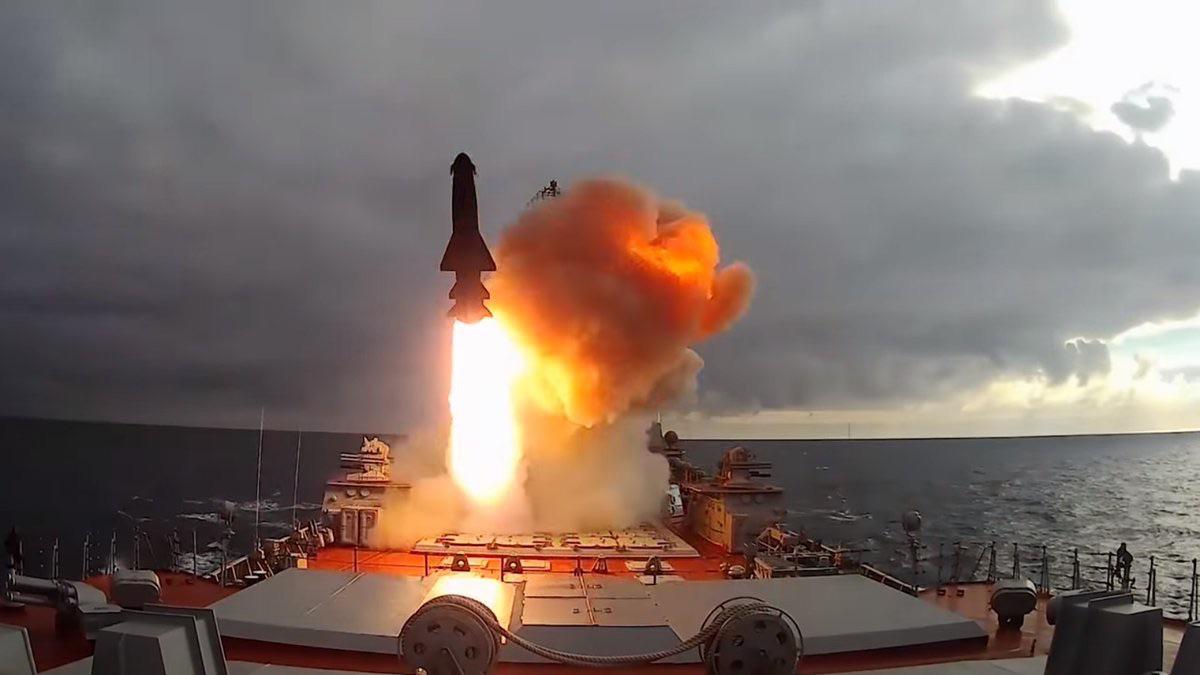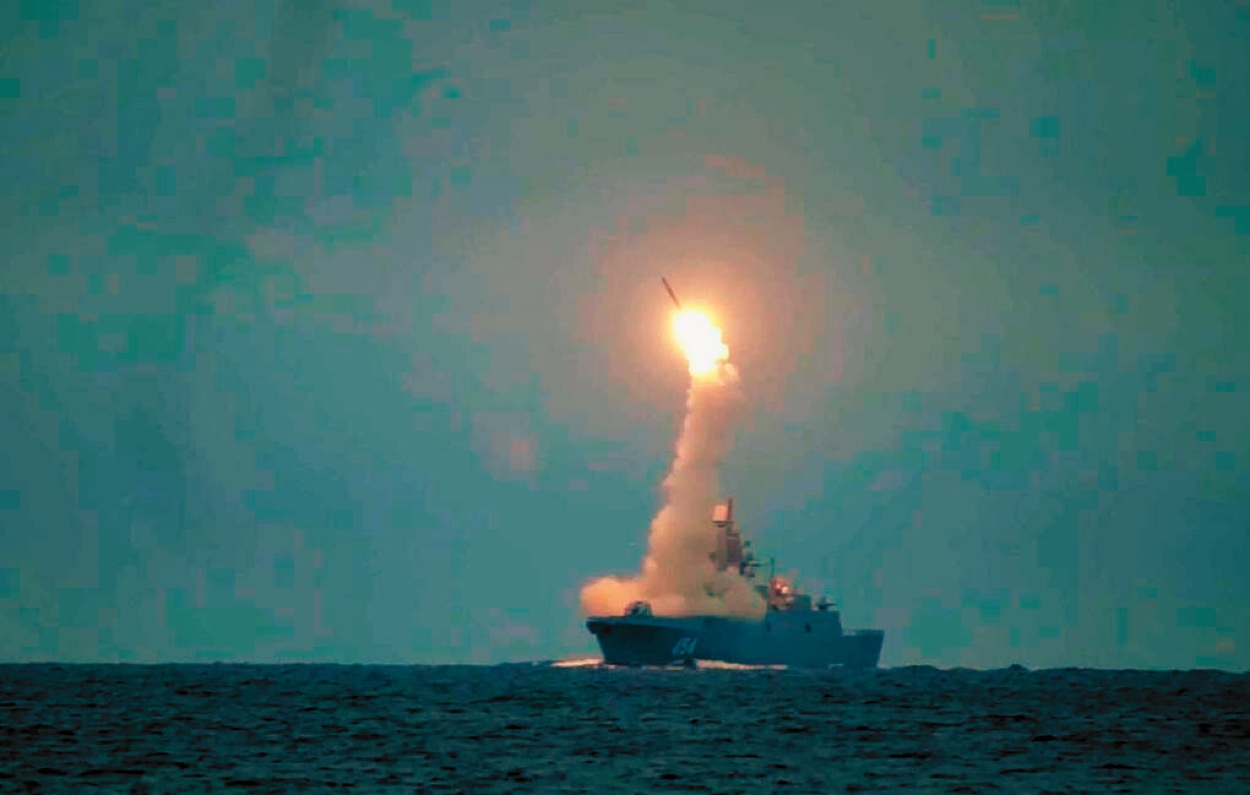On November 21, Russian Defense Minister Sergei Shoigu exhorted the country’s shipyards to construct multi-purpose ships with high-precision missile systems designed to destroy critical infrastructure and naval targets, including aircraft carriers and ship strike groups.
The head of the Russian Ministry of Defense, speaking at a meeting of the military department board, also urged that all components of the strategic nuclear forces be kept in constant readiness.
In his address, General Shoigu subtly articulated Russia’s intent to take on the challenge posed by the US leadership’s brashly articulated intent to weaken Russia. US carrier groups are key to maintaining US hegemony, and Russia appears to have taken note. But the task before Russia isn’t trivial.
The Challenge In Destroying An Aircraft Carrier
Aircraft carriers operate as carrier strike groups or as a task force comprising other warships and support ships. An aircraft carrier is typically equipped with a multi-layered defense system that includes close-in weapon systems (CIWS), medium-range missiles, and long-range air defense systems.
Additionally, other warships in the group or task forces have various air defense weapon systems that contribute to the overall defense.
During operations, the airspace around a carrier group is monitored round the clock by carrier-borne AEW&CS platforms.
Subsonic cruise missiles, such as the Kalibr, pose no threat to an aircraft carrier. They are easily detected and destroyed well before they come anywhere near a carrier group, even in the case of a saturation attack.
Russian Navy’s Ship-Based Anti-Aircraft Carrier Capability
Russian Navy ships currently deploy only one weapon system dedicated to sinking US aircraft carriers – the P-700 Granit (SS-N-19 ‘Shipwreck’) missile.
The 7,000 kg Granit is a giant with a 750-kg warhead with a 500 kt yield. It can fly at speeds up to Mach 1.6 at low altitude and Mach 2.5+ at high altitude. The Granit can also be armed with a thermonuclear warhead. The maximum range of 625 km.
A single Granit hit, even with a conventional warhead, would most likely cripple an aircraft carrier.
Russian Navy Kirov-class heavy guided-missile cruisers/battlecruisers are armed with the Granit missile. The nuclear-powered cruisers have a full load displacement of 28,000 t and can carry a complement of 20 x P-700 missiles.
However, only two Kirov class cruisers – Pyotr Velikiy and Admiral Nakhimov – are currently operational in the Russian Navy. Considering the small number of Russian ships armed with Granit missiles, their location would be known to the US Navy at all times.
The combat radius of carrier-based F/A-18C/D Hornet multirole fighter aircraft is approximately 300 nautical miles on internal fuel. When equipped with external fuel tanks or aerial refueling capabilities, the aircraft’s range can be extended.
As such, there is no chance that a Russian warship could approach a carrier group within the launch range of a Granit missile.
P-800 Oniks Missile
Russian P-800 Oniks missiles have the high supersonic speed and maneuverability to penetrate the defenses of a carrier group, and they are deployed on many warships and submarines.
However, their 300 kg warhead is much smaller than the 750 kg warhead of the Granit. The outcome of an engagement between a Russian Navy ship armed with Oniks missiles and a US Navy carrier group would depend on the specific circumstances, the countermeasures employed by the carrier strike group, and the success of the missile’s penetration through the carrier’s defenses.
Even in case of an adverse outcome, the chances that one, or even multiple, Oniks strike(s) could sink an aircraft carrier are minimal.
True, the number of Russian ships armed with Oniks missiles runs into scores, but then the US Navy maintains 11 carrier strike groups! Also, the challenge of approaching a carrier group within the launch range of an Oniks remains.
The Russian Navy additionally has many submarines armed with Oniks missiles which pose a good degree of threat to US carrier groups – if their whereabouts are not known to the US Navy.

The Granit Alternative
Coming back to what General Sergei Shoigu said in his address to the military department board – it is unlikely that he had the Oniks missile in mind during his address.
The Granit missile is due to be replaced as the Russian Navy’s carrier killer of choice with the 3M22 Zircon hypersonic cruise missile. The Zircon can reach speeds of up to Mach 8 and hit targets at ranges up to 500-1000 km.
Unlike the high supersonic speed Granit and Oniks, the hypersonic Zircon will be near impossible to intercept by carrier group air defenses.
The Zircon is believed to have a warhead weighing between 300 kg to 400 kg. However, its considerably higher speed would make it as destructive as the Granit. A Zircon strike, too, will likely cripple an aircraft carrier.
Project 22350 Warships
The Project 22350 frigate Admiral Golovko will be the first Russian Navy warship to be equipped with Zircon hypersonic missiles. The warship is fitted with 3S14 VLS cells which can be used to launch Kalibr, Oniks, or Zircon anti-ship cruise missiles.
Russian Defense Minister Sergei Shoigu told the military department board that Admiral Golovko is undergoing state tests.
Earlier on March 31, the Russian Ministry of Defense had reported that Admiral Golovko arrived at the main base of the Northern Fleet to conduct factory sea trials and state tests, as well as test firing at the fleet’s combat training ranges in the Barents Sea.
The warship is planned to be transferred to the Russian Navy this year.
Admiral Golovko is the third warship of its class. The lead and first production frigates, “Admiral of the Fleet of the Soviet Union Gorshkov” and “Admiral of the Fleet Kasatonov” have already been inducted into the Russian Northern Fleet.
Project 22350 ships are 1st-rank frigates designed for operations in the far sea zone. They are the largest warship of the modern Russian fleet of fresh construction.
Admiral Gorshkov and Admiral Kasatonov are currently armed with Kalibr-NK and Oniks cruise missiles. Admiral Gorshkov took part in testing the Zircon hypersonic missiles.

It is likely that Admiral Gorshkov and Admiral Kasatonov will be retrofitted with 3S14 VLS cells during the course of their next scheduled refit to enable them to launch Zircons.
It’s expected that future Project 22350 warships will all be armed with Zircon missiles. The Severnaya Verf shipyard has so far received orders for 6 Project 22350 warships. General Shoigu’s statement on the need for more such warships suggests a follow-up order for 6 more frigates may be on the cards. According to the Russian Navy’s deputy commander for armament, Vice Admiral Viktor Bursuk, the Russian Navy needs, at a minimum, 15 such frigates in basic and upgraded versions.
Other platforms that may receive Zircons are Gremyashchiy-class corvettes (fitted with UKSK VLS cells during their construction) and Udaloy-class anti-submarine warfare destroyers.
Conclusion
Russia is poised to build an anti-aircraft carrier capability based on the Zircon missile deployed on ocean-going warships such as Project 22350 frigates and Udaloy class cruisers.
The likely initial aim would be to deploy Zircons on Project 22350 frigates and 8 refurbished Project 1155/1155.1 Udaloy class destroyers to be fitted with 3S14 VLS cells.
It’s also proposed to deploy Zircon missiles on Yasen-class submarines and modernized Oscar-class submarines. In addition to the carrier-busting capability being deployed on its warships, Russia is also deploying hypersonic air-launched cruise missiles capable of crippling aircraft carriers.
- Vijainder K Thakur is a retired IAF Jaguar pilot. He is also an author, software architect, entrepreneur, and military analyst. VIEWS PERSONAL
- Follow the author @vkthakur




